-
current
recommendations- Liefdefjord
New page dedicated to one of Spitsbergen's most beautiful fjords. Background information and many photos.
- New Spitsbergen guidebook
The new edition of my Spitsbergen guidebook is out and available now!
- Liefdefjord
New page dedicated to one of Spitsbergen's most beautiful fjords. Background information and many photos.
Page Structure
-
Spitsbergen-News
- Select Month
- June 2025
- May 2025
- April 2025
- March 2025
- February 2025
- January 2025
- December 2024
- November 2024
- October 2024
- September 2024
- August 2024
- July 2024
- June 2024
- May 2024
- April 2024
- March 2024
- February 2024
- January 2024
- December 2023
- November 2023
- October 2023
- September 2023
- August 2023
- July 2023
- June 2023
- May 2023
- April 2023
- March 2023
- February 2023
- January 2023
- December 2022
- November 2022
- October 2022
- September 2022
- August 2022
- July 2022
- June 2022
- May 2022
- April 2022
- March 2022
- February 2022
- January 2022
- December 2021
- November 2021
- October 2021
- September 2021
- August 2021
- July 2021
- June 2021
- May 2021
- April 2021
- March 2021
- February 2021
- January 2021
- December 2020
- November 2020
- October 2020
- September 2020
- August 2020
- July 2020
- June 2020
- May 2020
- April 2020
- March 2020
- February 2020
- January 2020
- December 2019
- November 2019
- October 2019
- September 2019
- August 2019
- July 2019
- June 2019
- May 2019
- April 2019
- March 2019
- February 2019
- January 2019
- December 2018
- November 2018
- October 2018
- September 2018
- August 2018
- July 2018
- June 2018
- May 2018
- April 2018
- March 2018
- February 2018
- January 2018
- December 2017
- November 2017
- October 2017
- September 2017
- August 2017
- July 2017
- June 2017
- May 2017
- April 2017
- March 2017
- February 2017
- January 2017
- December 2016
- November 2016
- October 2016
- September 2016
- August 2016
- July 2016
- June 2016
- May 2016
- April 2016
- March 2016
- February 2016
- January 2016
- December 2015
- November 2015
- October 2015
- September 2015
- August 2015
- July 2015
- June 2015
- May 2015
- April 2015
- March 2015
- February 2015
- January 2015
- December 2014
- November 2014
- October 2014
- September 2014
- August 2014
- July 2014
- June 2014
- May 2014
- April 2014
- March 2014
- February 2014
- January 2014
- December 2013
- November 2013
- October 2013
- September 2013
- August 2013
- July 2013
- June 2013
- May 2013
- April 2013
- March 2013
- February 2013
- January 2013
- December 2012
- November 2012
- October 2012
- September 2012
- August 2012
- July 2012
- June 2012
- May 2012
- April 2012
- March 2012
- February 2012
- January 2012
- December 2011
- November 2011
- October 2011
- September 2011
- August 2011
- May 2011
- April 2011
- March 2011
- February 2011
- January 2011
- December 2010
- November 2010
- September 2010
- August 2010
- July 2010
- June 2010
- May 2010
- April 2010
- March 2010
- February 2010
- November 2009
- October 2009
- August 2009
- July 2009
- June 2009
- May 2009
- April 2009
- March 2009
- February 2009
- January 2009
- December 2008
- November 2008
- October 2008
- August 2008
- July 2008
- June 2008
- May 2008
- April 2008
- March 2008
- February 2008
- April 2000
- Select Month
-
weather information
-
Newsletter

| Guidebook: Spitsbergen-Svalbard |
Home
→ January, 2020
Monthly Archives: January 2020 − News & Stories
Anaesthetised polar bear died during transport
The polar bear that was anaesthetised and flown out last night died during the transport in the helicopter, according to the Sysselmannen.
The cause of death is currently unknown. A postmortem examination is expected to clarify this within a few days.
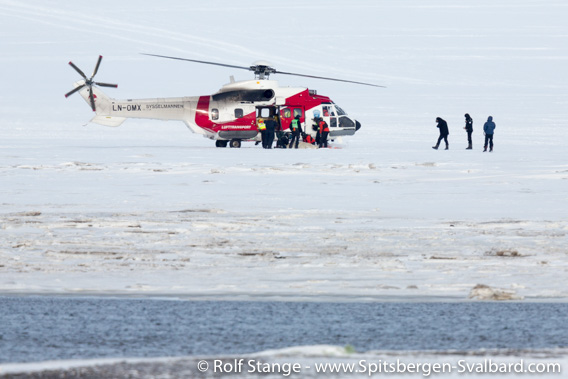
An anaesthetised bear during preparations for a helicopter flight to Nordaustland (archive image, 2016).
The bear is said to have been a female that was not tagged.
There is always a remaining risk inherent to anaesthesy, especially as the weight and health condition of the “patient” are mostly unknown or can, at best, be roughly estimated, something that must obviously have been difficult last night in darkness.
Anything beyond this is mere speculation at the time being until the results of the postmortem are available.
Again polar bear in Longyearbyen area, flown out
Again, a polar bear showed up in the Longyearbyen area. The bear was seen yesterday (Thursday, 30 January) at Hotellneset, close to the airport.

An anaesthetised polar bear during preparations for the flight to Kinnvika (archive image, 2016).
The Sysselmannen pushed the bear with the helicopter across Adventfjord to Hiorthhamn. Later, the bear was anaesthetised and flown out to Kinnvika on Nordaustland, about 200 km as the crow flies to the north. It is unlikely that this bear will return to Longyearbyen at any time soon, although this kind of distance and terrain are not an insurmountable obstacle for a polar bear. But chances that the bear has the orientation and motivation to set course for Longyearbyen now are low.
The last case when a bear was anaesthetised near Longyearbyen and flown out, also to Kinnvika, was in April 2016. This bear returned to Longyearbyen in late December 2019 and was shot in the early morning hours of New Year’s Day 2020.
Polar bear experts of the Norwegian Polar Institute were present during the whole operation, as the Sysselmannen informed on Facebook.
New reglations for protected areas on the west- and north coast of Spitsbergen
New regulations for the National Parks on the west coast of Spitsbergen – South Spitsbergen National Park and North Spitsbergen National Park – have been under discussion for a considerable time. They entered force on 20 December 2019, according to a press release by the Norwegian government.

New bird sanctuary Liefdefjord: Andøyane (seen here), Stasjonsøyane, Måkeøyane and Lernerøyane are included. Common eiders and other birds may have a hidden nest behind every driftwood log, so it has never been a good idea to walk around here during the breeding season. Now these islands are seasonally protected by law.
New regulations
There are a couple of changes relevant mainly for ship-based tourism in these areas. Expedition leaders, tour leaders and guides as well as individual tourists such as crews of private yachts need to be aware of these new regulations.
The most important ones are:
- There is a new bird sanctuary „Liefdefjord“, which includes the island groups of Andøyane, Stasjonsøyane, Måkeøyane and Lernerøyane. The protection mechanism is the same as for the older bird sanctuaries: all traffic is banned from the islands including the waters within 300 metres from the nearest shore from 15 May to 15 August.
This is probably the most relevant change for ship-based tourism and the only one that will involve important restrictions on regularly visited sites. - The bird reserve Blomstrandhamna on the north side of Blomstrandhalvøya is enlarged: now, Indre Breøya is also included.
- There is now a permanent traffic ban in an area around the warm springs of Trollkjeldene. The exact location is given by a map and a set of coordinates.
Trollkjeldene comprise several warm springs with sinter terraces south of Bockfjord, a couple of kilometres inland. They are not a frequently visited site. Jotunkjeldene, the smaller springs close to the shore in Bockfjord, are not included in the new regulations and can also be visited in the future (with care, please). - New site-specific guidelines will be introduced at a couple of locations. AECO will provide these guidelines to the Sysselmannen. These sites include: Ytre Norskøya, Sallyhamna and Smeerenburg (northwest Spitsbergen), Signehamna and Fjortende Julibukta (Krossfjord), Fuglehuken (Prins Karls Forland), Ahlstrandhalvøya (Van Keulenfjord), Gnålodden and Gåshamna (both in Hornsund).
- Things have actually even become easier in a few cases: non-motorised boats may pass close to the mainland coast within the 300 m zone of the bird sanctuaries of Boheman (near Bohemanneset in Isfjord) and Prins Heinrichøya / Mietheholmen (east of Ny-Ålesund in Kongsfjord). That will make life easier for kayakers. Any boat that has an engine has to stay outside the 300 m zone just as before, meaning that you can, for example, not pass between the mainland coast and Prins Heinrichøya / Mietheholmen with a Zodiac.
- Toilet water and greywater may not be discharged off within 500 metres from the coast. This was, so far, only valid within the Nature Reserves; now it is also in force in the National Parks.
- Motorised traffic on land is prohibited in the Nature Reserves (not new) and in the bird sanctuaries (also not new, but clarified). There is, however, an important exception: snow mobiles are allowed within the bird sanctuary at Kapp Linné until 14 May (the general rules apply, of course – no disturbance of wildlife, no driving on ground that is not frozen and snow-covered).
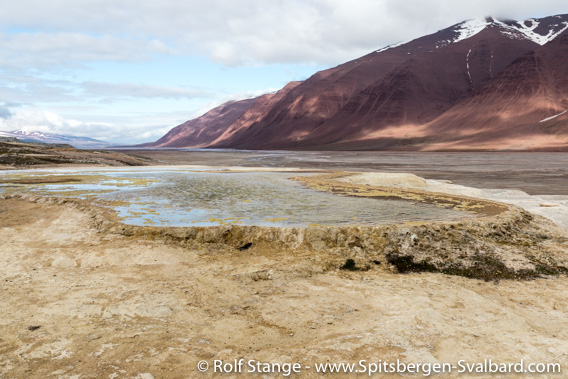
Trollkjeldene (Troll springs) in Bockfjord: from now on you have to keep some distance.
Jotunkjeldene, the springs which are close to the shore and more regularly visited, are not affected by new regulations.
All other existing regulations remain in force, including the possibility for trawling in depth greater than 100 metres.
Further current changes include mainly the exact wording of the regulations without implying much of a change in practice. For example, the bird sanctuaries or bird reserves are now „nature reserves for birds“ to make it clear that they have generally the same status as nature reserves, which are Norway’s most strictly protected areas.
More changes to come
The future will see further changes especially in central Spitsbergen: a new adminstration plan will look at important areas including Isfjord, Adventdalen which is next to Longyearbyen and Van Mijenfjord. Changes may include a ban on heavy oil in Isfjord and a maximum size (passenger number) of ships allowed to visit these waters. But these and other possible changes are part of another process that is currently in an early stage.
Monetary fine for disturbance of bird colony at Ossian Sarsfjellet
A tour operator has got a fine of 30,000.00 NOK (3,000 Euro) by the Sysselmannen for disturbance of breeding birds at Ossian Sarsfjellet in Kongsfjord. The ship run by the tour operator had dropped the anchor close to the cliff with the colony. The noise of the anchor chain caused disturbance of the birds, mainly Brünnich’s guillemots and kittywakes.
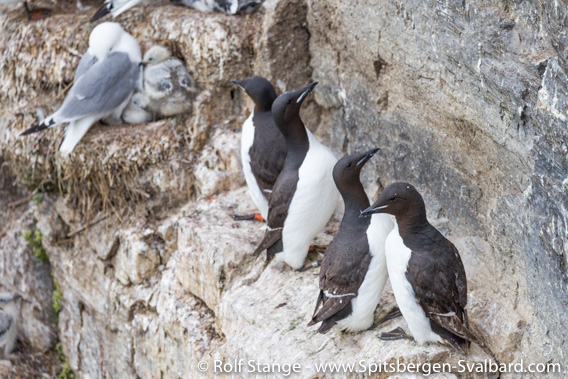
Brunich’s guillemots and kittywakes (upper left, with chicks) at Ossian Sarsfjellet.
Disturbance of breeding birds can have serious consequences, for example when eggs or flightless chicks fall out of nests on narrow ledges or when predatory birds such as glaucous gulls raid unguarded nests.
Polar bear again seen in Bolterdalen
Outdoor folks who want to get out near Longyearbyen can not yet return back to normal (whatever that means in Spitsbergen anyway). The polar bear that gave a group of tourists and guides with dog sledges a good adrenalin rush on Wednesday was seen again yesterday (Thursday) afternoon.
On Wednesday, the bear was pushed up Bolterdalen and into Tverrdalen by the Sysselmannen’s helicopter. The hope was that it would, after a rest, continue southwards. But the bear obviously had different ideas and returned to Bolterdalen, where it was met Thursday afternoon on Scott Turnerbreen (-glacier) by Tommy Jordbrudal and his colleague. Tommy has been running a small company offering dog sledge trips in that area for many years and was out to check the conditions on the glacier, which is a popular destination for dog sledge excursions. Scott Turnerbreen has an accessible ice cave and the area is largely snow-mobile free: only locals are allowed to drive there with snow mobiles and even for them Bolterdalen and a wide area around it are off limits for motorised traffic from 01 March every year, meaning that locals and tourists can enjoy a silent area for silent excursions by ski or dog sledge.
But polar bears are not banned from the area, so Tommy and his colleage suddenly had a polar bear just a few metres away from them, investigating their snow mobile. Even a warning shot with a revolver did not make much of an impression on the bear.
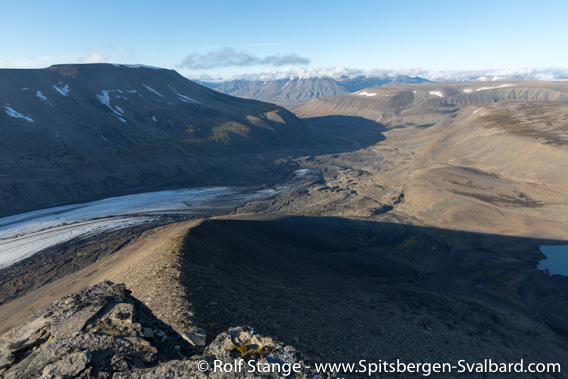
Bolterdalen (seen from Soleietoppen): currently not a polar-bear-free area.
Scott Turnerbreen on the left hand side.
Tommy has been running trips in Bolterdalen for 12 years now, so during the season he and his guides are there on a very regularly basis and he says that he has never seen a polar bear track or even a bear there before. Now the Sysselmannen went out again by helicopter, trying to sort the situation out.
This author hopes that he does not have to write again about incidents where life, human or animal, came to any harm.
Norwegian government wants to discuss certification requirements for guides
The discussion about formal requirements for guides is not new, but it has now got a significant boost as the Norwegian government has declared a need for this discussion.
“Guide” is, so far, not a formally qualified profession. There are efforts, private and industry-based, to introduce certification for guides, but until now, basically everybody can come, claim to be a guide and try to find work. This has actually worked well over many years as a limited number of tourists was met by an also limited but sufficiently large number of guides who were enthusiasts of the outdoors and had, as such, built up sufficient knowledge, skills and experience to lead tourists in arctic nature, summer or winter, by ski, dog sledge, snow mobile, boat, ship, hiking, whatever.
But times have changed. Recent years have seen a number of new companies who want their share of the tourism market in the Arctic, often in the attractive day trip market in Longyearbyen’s surroundings. A “market”: that’s what it is now, a market with a huge turnover where a lot of money is made by some. Not a niche anymore where a limited number of enthusiasts find their way of life with a lot of personal idealism and effort. Of course they still exist, but the total picture is by now far more complex.
The grown and still growing market implies an increased need for guides, and it is not just a few observers who are not always satisfied with the level of knowledge, experience and skill that they see.
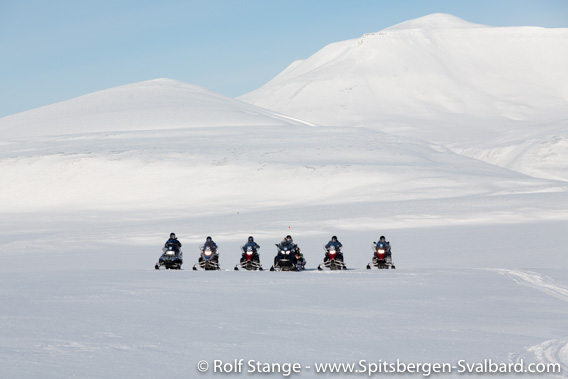
Tourist group with guide in Colesdalen: guide is, so far, an open profession.
This is not just annoying, but may also be dangerous. In Spitsbergen, guides handle weapons, boats, snow mobiles and dog sledges on a regular basis, they deal with arctic weather, have to expect meeting a polar bear at any time in the field and take responsibility for the safety of people in these conditions. Additionally, guides are a key factor when it comes to environmental issues. It is fully possible to visit cultural heritage sites, observe wildlife and walk in the nature without destroying or disturbing anything, but the opposite may also happen and competent leadership out in the field is key in this context.
Seen in this light, one may wonder why certification requirements for guides have not already been introduced a long time ago, also as an alternative to closing sites and even large areas, as was discussed no less than a good 10 years ago. Even the local industry sector organisation Visit Svalbard has now expressed themselves positively towards this issue – of course expecting to be part of such a process. Everybody in the business knows that for example a serious accidents would do harm not only to those directly involved but to the whole industry if it turns out that lack of qualification on behalf of the guides was a factor.
Safety and environmental matters are issues that local guides have also been aware of for quite a while, according to the Svalbard Guide Association. And of course “old” guides with years of solid experience are not always happy when young colleages without relevant experience and skills come and take their jobs, an issue that is relevant not only for environmental and safety concerns but also when it comes to working conditions in the industry.
Spitsbergen’s glacier will, however, probably still lose a good bit of ice until requirements for guide certification has been formalised on a legal level: The Norwegian government’s recent press release just indicated a need to discuss the issue. There are still a lot of practical questions to be answered regarding the qualification and certifaction process.
Close encounter with polar bear in Bolterdalen
Yet again, a polar bear has been in the area near Longyearbyen. This time, it was not just tracks in the snow, but a very close encounter of a group of 4 dog sledges with guides and tourists in Bolterdalen. The group was returning from Scott Turnerbreen, a glacier that is a popular destination for (half) day trips by dog sledge, to the dogyard of Green Dog in Bolterdalen close to Adventdalen. Suddenly the bear was standing on a terrace next to the route, much to everybodies surprise, probably including the bear. The bear came and sniffed on the dogs of the first sledge, while the tourists on the sledge – a woman and her 11 year old daughter – were watching. The guide, Marcel Starinsky from Slovakia, realised that he did not even have time to get is rifle ready. Instead, he grabbed a piece of rope and gave the bear a slab on the nose. Then, the bear went a bit away, passed the other sledges and disappeared in the darkness. The whole event took probably less than a minute, as the guides told Svalbardposten later.
The group then returned to the dogyard and guides and tourists took their time together to digest this very unusual experience. As far as known, everybody had his or her nerves under control during the event and according to Marcel Starinsky and his colleague, Daniel Stilling Germer from Denmark, the bear did not show any signs of aggression. It would be interesting to hear the story from the woman and her daugher on the first sledge. They have certainly got a story to tell now.
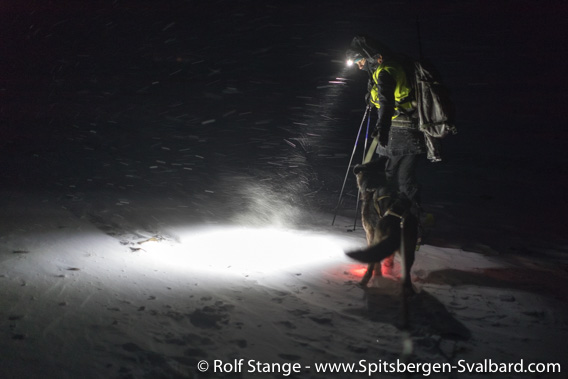
Out on tour in darkness and snow.
It can be virtually impossible to see what is going on nearby.
Later, the polar bear was again seen near the dogyard, but was then driven away by the Sysselmannen’s helicopter through Bolterdalen and towards Reindalen.
It is hard to say if this bear had anything to do with the tracks that were recently seen on Longyearbreen. These tracks were followed by the Sysselmannen the west, up to Kapp Laila in Colesbukta, whereas the bear in the event narrated here is assumed to have come from Adventdalen, from the east. This at least suggests that it is not one and the same animal.
Polar bear track near Longyearbyen
A polar bear track has been found on Longyearbreen (-glacier) close to Longyearbyen, according to the local newspaper Svalbardposten. It is very unlikely that the track is from the bear that has kept people in Longyearbyen excited in late December and was then shot on 01 January: meanwhile, there have been windy weather and snowfall, so the recently discovered tracks are very likely younger. This means that there was again a polar bear close to Longyearbyen and it might still be around.
Common sense and the Sysselmannen tell everybody in and near Longyearbyen to be alert and take care.

Polar bear tracks (archive image; it is dark now in Spitsbergen 🙂 ).
As expected, the discussion around the bear that was shot in the early morning hours of New Year’s Day in Hanaskogdalen, about 10 kilometres away from Longyearbyen, is highly controversial. Norwegian officials confirm that they had to shoot the bear in order to guarantee the safety of the people in Longyearbyen especially during the dark season as this animal was not shy anymore and did not hesitate to go near and even enter the settlement. Others, such as the Russian polar bear scientist Nikita Ovsyanikov who has gathered a lot of experience with polar bears in the Russian Arctic, even speak of “murder” and accuse the Syssselmannen of not having used all options to scare the bear away permanently. Here, Ovsyanikov mentions pepper spray which is not a common polar bear deterrent in Norwegian territories, it is actually not even legal accessible for mere mortals under Norwegian legislation. An interesting discussion and it would certainly be interesting to investigate further non-lethal techniques to scare polar bears away from settlements, a field where a lot might be learnt from people like Ovsyanikov. Pepper spray might certainly expand the range of options of Norwegian police when it comes to non-lethal polar bear deterrents and there are those who say that it might also have a place in a wide context. Private persons might use it, for example, from the relative safety of a hut or even a tent, something that would, however, require knowledge and nerves that not everybody has.
To make it clear again: pepper spray is currently not legal in Norway including Spitsbergen and this is unlikely to change at any time soon.
100 years ago: Spitsbergen’s largest mining accident
Spitsbergen’s largest mining disaster ever took place exactly 100 years ago, 03 January 1920, in mine 1 in Longyear City. The mine is today mostly known as the “American mine” and Longyear City is called Longyearbyen since 1926. Mine 1 was in operation from 1906, when Longyear City was founded by the American Arctic Coal Company, founded and owned by John Munro Longyear. In 1916, Longyear sold his property to the Norwegian company Store Norske Spitsbergen Kulkompani, known as Store Norske, short SNSK. Store Norske continued to produce coal in mine 1 (later called mine 1a, as there was a mine 1b in operation from 1939 above Sverdrupbyen, the southernmost part of Longyearbyen).
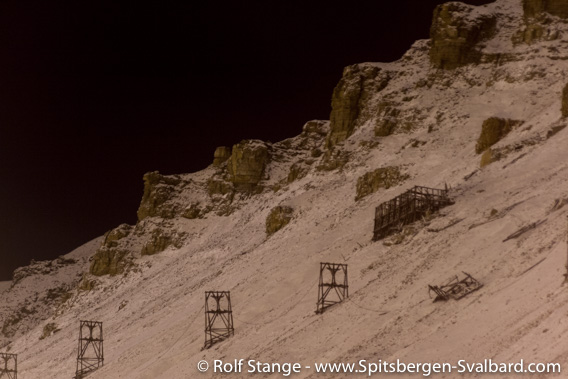
Mine 1, known as “American mine”, above the church in Longyearbyen.
26 miners died here during a coal dust explosion in 1920.
Mine 1 exploded in the early morning hours of 03 January 1920. It was a coal dust explosion that killed 26 miners. There were only eight survivors, two of them injured. Blasting is supposed to have ignited the coal dust. The explosion was so strong that a pit pony is said to have been blown out of the mine and across the valley!
This accident was a catastrophe for the small mining settlement Longyear City/Longyearbyen, which was back then completely isolated during the polar night. Darkness and bad weather made rescue operations difficult. Mine 1 was closed after the accident.
With 26 victims, this accident remains the largest catastrophe related to mining ever in Spitsbergen (the explosion in the Esther mine in Ny-Ålesund on 05 November 1962 killed 21 miners).
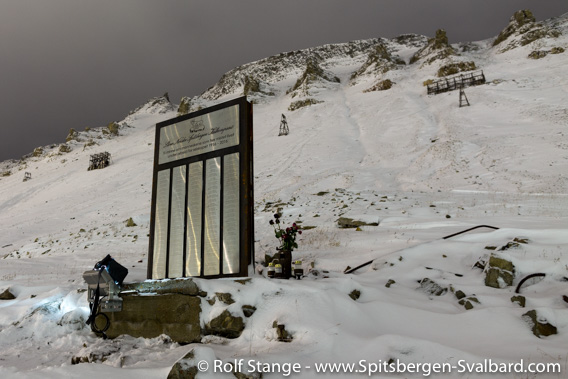
Memorial for those miners who died during their work for Store Norske from 1916.
Mine 1 is visible in the upper right corner.
A memorial was erected in 2016 near the road below mine 1. It is dedicated to those miners who died during their work for Store Norske Spitsbergen Kulkompani since the company bought Longyear City in 1916. Today, 100 years after the accident of 03 January 1916, a ceremony will be held here to commemorate those who died in Spitsbergen’s largest mining accident.
Shot polar bear was already flown out in 2016
The polar bear that was shot on New Year’s Day at 4 a.m. turned out to be an old acquaintance. It was a seven year old male.
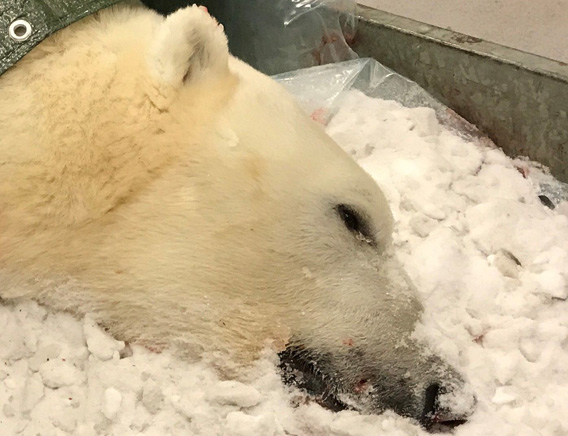
The polar bear that was shot on New Year’s Day 2020. Photo © Sysselmannen på Svalbard.
As it turned out, it was the same bear that was around Longyearbyen for several days in April 2016. Personally, I had a little meeting with this very bear in mid April back then as I stepped out of a hut in Sassenfjord and noticed this bear not far away at all. It had also noticed me and was already on the run. Most likely, it was the same bear that was shot yesterday. Back then, it was seen several times near various huts.
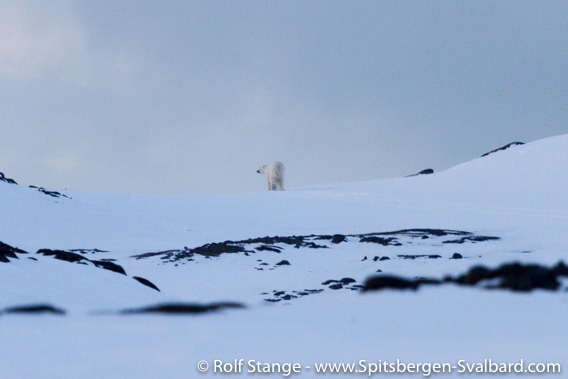
Better days: the bear is running away after a brief, harmless encounter in Sassenfjord.
It was very likely the animal that was shot on New Year’s Day 2020.
A few days later, mid-day on 22 April 2016, this bear was suddenly seen near the shore in Adventdalen, an area that is frequented by large numbers of snow-mobile tourists, skiers and dog sledges. Back then, the bear was aanaesthetised and flown out to Kinnvika on Nordaustland, a good 200 km away from Longyearbyen.
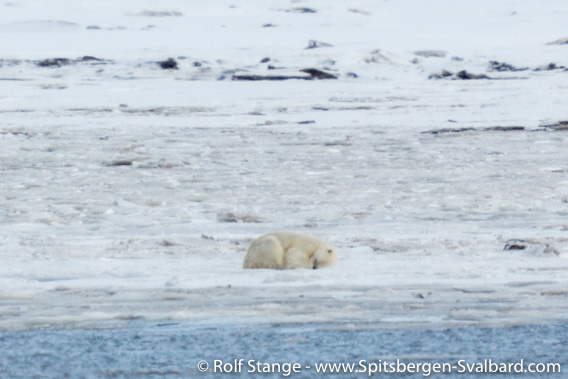
The polar bear on 22 April 2016, sleeping peacefully in Adventdalen near Longyearbyen.
It is the same bear that was shot on New Year’s Day 2020.
So this bear showed up again just after Christmas 2019, after three and a half years, near and even within Longyearbyen. Several attempts to scare it away with helicopters and other means failed in the end, and the Sysselmannen decided to kill this bear. This happened in Hanaskogdalen, about seven kilometers north of Longyearbyen.
Aggressive behaviour of this bear towards humans is, as of now, not publically known.
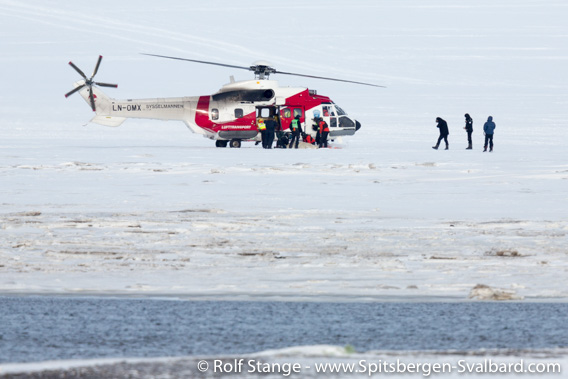
In April 2016, the bear was anaesthetised and flown out.
Also this time it was considered to anaesthetise the bear and fly it out then. According to official statements, the lack of experts in Longyearbyen due to the Christmas holidays was the main reason why this did not happen.
It is not surprising that the killing of the bear is now met with a lot of criticism and a controversial, partly heated, debate in social media.
Polar bear shot near Longyearbyen
The new year starts with sad news: the polar bear that had been seen several times close to and within Longyearbyen was shot on New Year’s Day at 04 a.m. by police forces (Sysselmannen).
Just after midnight, the bear had been seen in Adventdalen close to the settlement after it had disappeared in Bjørndalen in bad weather on Saturday. It seems as if the Sysselmannen initially managed to scare it away from Longyearbyen last night.

Polar bear in central Longyearbyen (Thursday morning).
Photo © Sysselmannen på Svalbard.
The bear was shot in Hanaskogdalen, on the north side of Adventdalen, at 04 a.m. According to a press release by the Sysselmannen, the bear was not shot in a acute situation. The behaviour of the bear, which had been seen four times close to or even within the settlement area, had been considered and the official conclusion was that authorities were not able to guarantee public safety with the available forces anymore.
The option to tranquilize the bear and to aenesthetise the bear to fly it out to somewhere more remote had also been considered, but discarded due to the lack of absense of specialists who were not in Longyearbyen at that time due to the Christmas holidays.
News-Listing live generated at 2025/June/15 at 03:55:16 Uhr (GMT+1)




























